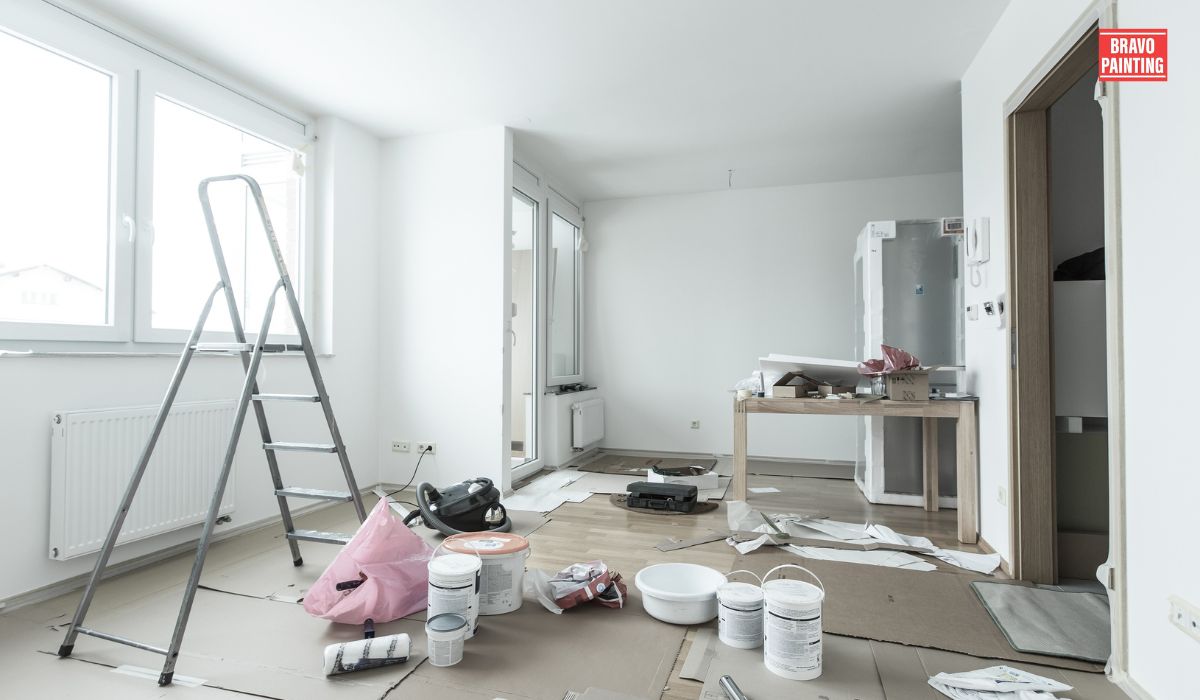Painting, an age-old practice that transforms spaces into works of art serves both functional and aesthetic purposes. Whether it’s a cozy home or a bustling commercial establishment, the choice of paint and the techniques employed can significantly impact the atmosphere and longevity of the space. In this comprehensive exploration, we delve into the nuances that differentiate residential and commercial painting.
Brief Overview
Painting, beyond its decorative function, plays a crucial role in protecting surfaces from wear and tear. Understanding the distinctions between residential and commercial painting is paramount for achieving optimal results.
Importance of Choosing the Right Type of Painting
The choice between residential and commercial painting goes beyond personal preferences. It involves considering the scale, purpose, and unique requirements of the space being painted.

Understanding Residential Painting
Definition and Scope
Residential painting involves enhancing the aesthetics of homes, apartments, and other living spaces. The focus is on creating a warm and inviting ambiance that aligns with the occupants’ preferences.
Residential Painting Techniques
Brush and Roll Technique
The traditional brush and roll technique is a meticulous process that ensures precision in detailing, making it suitable for residential interiors.
Spray Painting
Spray painting, on the other hand, provides a faster and more even coverage, making it ideal for more extensive residential exteriors.
Factors Influencing Residential Paint Choices
Aesthetic Preferences
Residential painting decisions are often driven by individual tastes and style preferences, reflecting the personalities of the inhabitants.
Durability
Considering the wear and tear of daily life, durability becomes a crucial factor in choosing the right paint for residential spaces.
Weather Considerations
Exterior residential painting requires careful consideration of weather conditions to ensure the longevity of the paint job.
Characteristics of Residential Paints
Types of Residential Paints
Latex Paints
Known for their quick drying time and low toxicity, latex paints are a popular choice for residential interiors.

Oil-Based Paints
Oil-based paints, with their durability and rich finish, find favor in high-traffic areas of residential spaces.
Color Trends in Residential Painting
Staying abreast of color trends allows homeowners to infuse a fresh and modern appeal into their living spaces.
Innovative Residential Painting Products
The market offers innovative products like textured paints and peel-and-stick wallpapers, providing homeowners with creative options.
Challenges in Residential Painting
Surface Preparation
Achieving a flawless finish in residential painting begins with thorough surface preparation, addressing issues such as cracks and imperfections.
Dealing with Interior Spaces
Navigating the intricacies of painting interiors involves careful planning to avoid disruptions to daily life.
Weather Constraints in Outdoor Residential Painting
External factors like humidity and temperature can affect the drying time and overall quality of exterior residential paint jobs.
The Art of Commercial Painting
Defining Commercial Painting
Commercial painting extends beyond aesthetics to encompass the branding and functionality of business spaces.
Specialized Techniques in Commercial Painting
Electrostatic Painting
Electrostatic painting is a technique often employed in commercial settings for its efficiency in covering large surfaces.
Airless Spray Painting
Commercial spaces benefit from the speed and uniformity offered by airless spray painting techniques.
Considerations for Large Commercial Spaces
The sheer size of commercial properties demands careful planning and execution to ensure a cohesive and professional appearance.
Types of Commercial Paints
High-Performance Coatings
Commercial paints often involve high-performance coatings, providing durability and resistance to heavy foot traffic.
Fire-Resistant Paints
Safety considerations in commercial spaces lead to the use of fire-resistant paints to comply with building codes.
Anti-Graffiti Coatings
Protecting the exterior of commercial buildings involves the use of anti-graffiti coatings, minimizing maintenance costs.
Tailoring Colors for Commercial Spaces
Psychology of Colors in Commercial Environments
Understanding the psychological impact of colors aids businesses in creating the desired atmosphere for customers and employees.
Branding and Corporate Color Schemes
Commercial painting aligns with branding strategies, incorporating corporate color schemes to enhance brand identity.
Overcoming Challenges in Commercial Painting
Scaling Up Operations
Large-scale commercial projects require efficient project management to meet deadlines and maintain quality.
Coordination with Other Trades
Collaboration with other trades in commercial construction is essential to ensure a seamless and integrated final result.
Compliance with Regulations
Commercial painting must adhere to strict regulations, including environmental considerations and safety standards.
The Intersection: Residential-Commercial Properties
Hybrid Painting Techniques
Properties with both residential and commercial aspects require a nuanced approach, blending techniques to meet diverse needs.
Challenges Faced in Dual-Purpose Properties
Balancing residential comfort with the functionality of commercial spaces poses unique challenges for painters.
Sustainability in Painting
Eco-Friendly Paint Options
The shift towards sustainability influences the use of eco-friendly paints, contributing to a healthier environment.
LEED Certification and Painting Practices
Commercial spaces aiming for LEED certification prioritize environmentally responsible painting practices.
Trends in Sustainable Painting
Innovations in sustainable painting include recycled paint and plant-based alternatives, reducing the carbon footprint of painting projects.
Hiring Professional Painters
Importance of Skilled Painters
The success of any painting project hinges on the expertise and skill of the painters involved.
Credentials to Look for in Residential Painters
Residential painters should possess the necessary certifications and experience to handle the intricacies of home painting.
Commercial Painting Contractor Criteria
Commercial painting contractors must demonstrate a track record of successful large-scale projects and compliance with industry standards.
Cost Considerations
Residential Painting Budgeting
Homeowners must carefully budget for residential painting, considering factors like room size and the desired finish.
Commercial Painting Cost Factors
Commercial painting costs vary based on the size of the space, the intricacy of the project, and the type of paint used.
Balancing Quality and Budget
Striking a balance between quality and budget is crucial for both residential and commercial painting projects.
Technological Advances in Painting
Robotics in Commercial Painting
Automation in commercial painting, through the use of robotics, enhances efficiency and precision.
Virtual Reality for Design Visualization
Virtual reality aids in visualizing paint colors and designs, allowing for more informed decision-making.
Maintenance Tips for Painted Surfaces
Residential Paint Care
Homeowners can prolong the life of their residential paint by following simple maintenance tips.
Commercial Space Maintenance
Regular maintenance of commercial paintwork ensures a professional and welcoming appearance.
Conclusion
In summary, residential and commercial painting are intricate practices with distinct considerations. Residential painting focuses on creating inviting spaces, utilizing techniques like brush and spray painting, diverse paints, and innovative products. Commercial painting extends beyond aesthetics to branding, employing specialized techniques, high-performance coatings, and color psychology.
Hybrid properties, combining residential and commercial elements, pose unique challenges. Sustainability is a growing trend, featuring eco-friendly options and LEED certification. Skilled painters, budget balancing, and technological advancements, including robotics and virtual reality, play crucial roles in the evolving industry.
Explore Bravo Painting for your project at Bravo Painting, where expertise meets artistry for exceptional results.
FAQs
What is the primary difference between residential and commercial painting?
Residential painting focuses on enhancing homes and living spaces aesthetically, while commercial painting extends beyond aesthetics to include branding and functionality of business spaces.
Why is choosing the right type of painting necessary?
The choice involves considering the scale, purpose, and unique requirements of the space, impacting both aesthetics and longevity.
What are the fundamental techniques in residential painting?
Residential painting techniques include the meticulous brush and roll method for interiors and the faster, more even spray painting technique for more extensive exteriors.
What influences the choice of residential paint?
Factors include aesthetic preferences, durability for daily wear and tear, weather considerations for exteriors, and staying updated on color trends.
What challenges are faced in residential painting?
Challenges include thorough surface preparation, navigating interior spaces, and dealing with weather constraints in outdoor painting.
How does commercial painting differ from residential?
Commercial painting goes beyond aesthetics to influence branding and functionality, often involving specialized techniques and coatings for larger spaces.
What are specialized techniques in commercial painting?
Techniques such as electrostatic painting and airless spray painting are commonly used for efficiency in covering large commercial surfaces.
How do colors play a role in commercial painting?
Understanding the psychology of colors is crucial for creating desired atmospheres, and commercial painting aligns with branding through corporate color schemes.
What challenges are faced in commercial painting projects?
Challenges include:
- Scaling up operations.
- Coordinating with other trades in construction.
- Ensuring compliance with strict regulations.
How are dual-purpose properties painted?
Properties with both residential and commercial aspects require a nuanced approach, balancing techniques to meet diverse needs.
How does sustainability impact painting practices?
Sustainability influences the use of eco-friendly paints, with innovations like recycled paint and plant-based alternatives reducing the carbon footprint.
Why is hiring skilled painters important?
The success of any painting project relies on the expertise and skill of the painters involved, ensuring quality results.
What credentials should residential painters have?
Residential painters should possess the necessary certifications and experience to handle the intricacies of home painting.
What criteria should commercial painting contractors meet?
Commercial painting contractors must demonstrate a successful track record in large-scale projects and compliance with industry standards.
How do technological advances impact painting?
Robotics enhance efficiency and precision in commercial painting, while virtual reality aids in design visualization for both residential and commercial projects.
Commercial Painting

